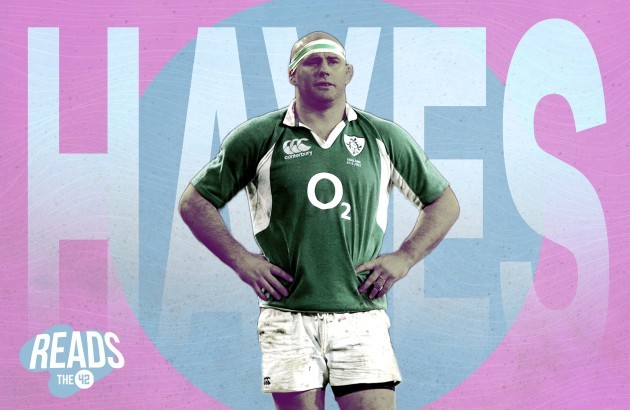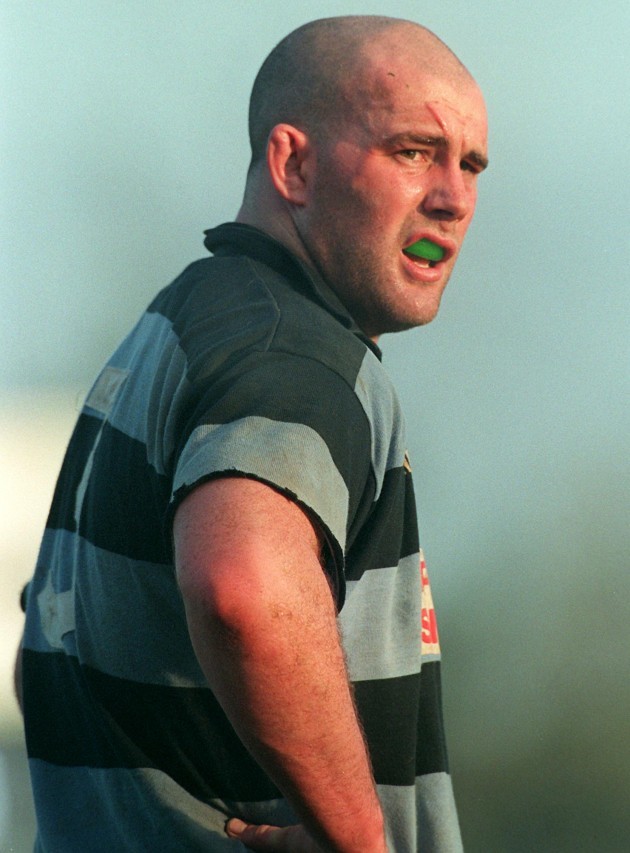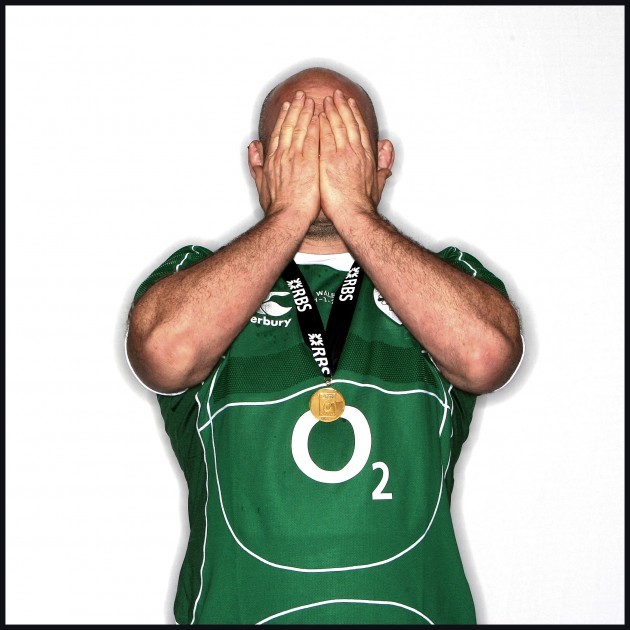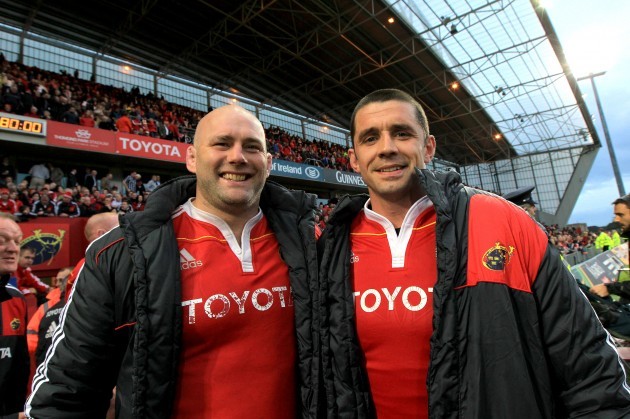JOHN HAYES DIDN’T score too many tries. They weren’t really his thing.
There were six of them in total across his 217 Munster games, 105 Ireland caps, and two Test appearances for the Lion. And Hayes’ most famous score gets him a slagging to this day.
It came in Munster’s thrilling Heineken Cup semi-final win on a sun-drenched, boisterous day in Toulouse in 2000. The big man from Cappamore had made a carry and was still kneeling on the ground ahead of play when Dominic Crotty broke through two phases later and offloaded for Hayes to score.
“There was a period of 10 seconds that we all counted on the replay where he hadn’t got up off the ground,” says Alan Quinlan, who played with Hayes for Munster and Ireland.
“He always says that 10-second gap fooled the opposition and he was in the right place at the right time.”
To be fair, Hayes delighted in the slagging at a time when it was relentless. Characters like Donncha O’Callaghan, Frankie Sheahan, and Quinlan would lead the way in the Munster and Ireland changing rooms. Despite the fact that he was seen as a quiet man to those on the outside, Hayes loved it.
‘The Bull’ was never bothered about public perceptions of him and it was no surprise that he comfortably slipped back into life on the farm after retiring from professional rugby in 2011 following a decade of being a cornerstone for province and country.
Ireland have two top-class tightheads in Tadhg Furlong and Andrew Porter now but that wasn’t always the case.
- For more great storytelling and analysis from our award-winning journalists, join the club at The42 Membership today. Click here to find out more >
Hayes was an indispensable figure for Ireland, making his debut against Scotland in 2000 and starting every single Six Nations game between then and the end of the 2010 championship, whereafter Mike Ross took over as the starting tighthead.
“I don’t think there will be too many props who catch his caps record,” says Ross. “He was tremendously strong, tremendously durable.”
Hayes also started eight of Ireland’s 10 World Cup games in 2003 and 2007. He never got the headlines bigger stars like Brian O’Driscoll, Paul O’Connell, Ronan O’Gara, and Tommy Bowe enjoyed but he was always a vital cog.
“He did all the jobs that you don’t get huge praise or much credit for,” says Bowe of Hayes. “He was world-class at those things.”
Being world-class certainly wasn’t in Hayes’ mind when he first played at Bruff RFC at the age of 18. He was a second row when Quinlan, playing for Clanwilliam at that time, came across him in 1993. The pair of them hit it off immediately.
“He was a farmer and I was a farmer too,” says Quinlan. “My dad and his dad had great auld chats over the years too.”
They were soon team-mates in Shannon before Hayes headed to New Zealand in 1995 for a stint that saw him convert to tighthead. When he came back to Shannon, Hayes still flitted between the two positions, but Niall O’Donovan could see his potential at tighthead and Hayes pushed on to make his Munster debut in 1998.
The ’90s were good times in Shannon as they won four consecutive All-Ireland Leagues, with Hayes bonding with the likes of Quinlan, Mick Galwey, and the late Anthony Foley. Hayes didn’t drink much in his later years as a pro, but Quinlan recalls great craic back then.
“The most important thing on a night out for John was the chipper afterwards. We were in a chipper one night in Kilkenny and there was a big queue. All the way up along towards the counter, there was a shelf with bits of food, leftover chips. John started eating everything and by the time he got to the counter, he was full!”
Moving permanently to tighthead meant there were teething problems for Hayes, including a Munster game against Perpignan in ’98 when Declan Kidney introduced him from the bench but took him off again 20 minutes later.
“He got his pilot’s license in a couple of scrums there,” says Quinlan with a chuckle.
But Hayes’ rapid rise was no laughing matter and he never looked back after being handed his Ireland debut by Warren Gatland against the Scots in 2000 on a day Peter Stringer, Ronan O’Gara, Shane Horgan, and Simon Easterby all won their first caps too.
By the time Bowe properly broke into the Ireland set-up in the mid-2000s, Hayes was one of the senior figures. An unlikely couple in many ways, the young Ulster wing and Munster prop ended up rooming together for a couple of seasons.
“He was an established player and I’m sure he was wondering what the hell he had done to get stuck with me,” laughs Bowe.
“But he was brilliant. I remember him telling me stories of when he was a young fella rooming with Peter Clohessy and how Claw used to never sleep, how he used to just sit up late and be ordering room service at three or four o’clock in the morning.”
Two-time Heineken Cup winner Hayes wasn’t averse to occasionally telling Bowe to shut up at night time, but he enjoyed the fun when the younger Ireland squad members gathered in their room.
“Remember Chat Roulette?” says Bowe. “Well, all the young lads used to pile into our room and we’d be on that. Hayes would be sitting up on his bed with a big grin from ear to ear soaking it all up.”
As well as being fond of a laugh, Hayes was a serious player whose approach to training was disciplined. Bowe recalls how the tighthead would never wear wet gear or thermals even when it was raining or snowing.
“No matter how cold and wet it was, no matter how much Donncha and the boys ripped the piss out of him, he would only ever train in just the jersey and shorts.
“He was a hard, hard man.”
Hayes’ toughness was a key trait. Ross, his rival for the number three shirt in the years before the Munster man’s retirement, remembers colliding with him in a ruck once.
“I might as well have been hitting a bloody telegraph pole, he was just so strong.”
While others were grabbing the attention by making the linebreaks, fielding high balls, offloading, and scoring tries, Hayes was the kind of player who made everyone else’s life easier.
His scrummaging improved over the years, he was good at carrying out his specific role in set plays, he tackled well, cleared out rucks, made occasional carries close to the ruck, and also specialised in lifting team-mates in lineouts or at restarts.
Hayes and O’Connell would constantly get David Humphreys to kick restarts onto them after training as they worked on one-man lifts.
“He could lift you with one hand in a lineout,” says Quinlan. “I was on the receiving end so many times and the way he would protect and block you. He was devastating in mauls as a blocker, someone who would stop the opposition from getting in on our ball.”
It never bothered Hayes that most people didn’t notice his contributions around the pitch, his work-rate to fill in space around the pitch in defence, his set-piece efforts. Others were in demand for interviews and got the boot deals, but Hayes didn’t crave the limelight.
“He was never happier than on a Tuesday or a Sunday morning when he got into his big Toyota Land Cruiser and gave you a big thumbs up out the window as he sped off back to his farm again,” explains Bowe. “He just loved getting back home onto the farm.”
Bowe also points out that family has always been first for Hayes. His wife, former Ireland Women international Fiona Steed, was a great supporter and driver of Hayes’ rugby career.
While Bowe was blasting out ‘Black Velvet Band’ in front of thousands of Ireland fans at Mansion House in Dublin the day after the Grand Slam victory in 2009, Hayes was already back home with his daughters, Sally and Róisín, the latter of whom was just a few weeks old at the time.
“That tallies with the kind of person John is,” says Ross.
In recent years, Hayes has been out coaching in Bruff, where his son, Bill, and two daughters play.
“He’s content now back home on the farm,” says Quinlan. “He always says now that he doesn’t miss the meetings about meetings about meetings. Sometimes he felt the game was over-analysed.
“He just turned up, knew his job, and got stuck in.”
For more great storytelling and analysis from our award-winning journalists, join the club at The42 Membership today. Click here to find out more >




